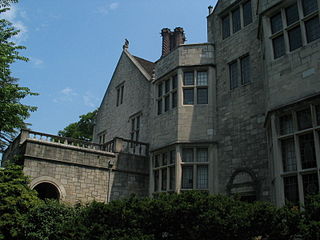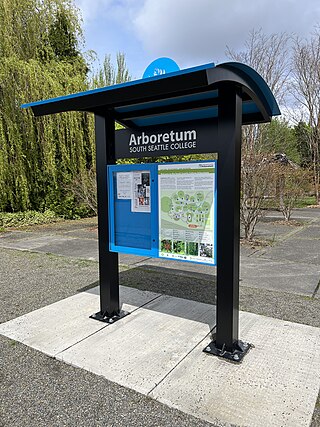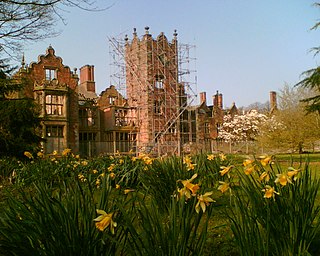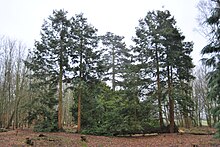
Mainau[ˈmaɪnaʊ](listen) also referred to as Mav(e)no(w), Maienowe, Maienow, Maienau, Mainowe and Mainaw is an island in Lake Constance. It is maintained as a garden island and a model of excellent environmental practices. Administratively, the island has been a part of Konstanz since December 1, 1971, when the municipality of Litzelstetten, of which Mainau was part, was incorporated into Konstanz. Mainau is still part of Litzelstetten, now one of 15 wards of Konstanz.

An arboretum is a botanical collection composed exclusively of trees of a variety of species. Originally mostly created as a section in a larger garden or park for specimens of mostly non-local species, many modern arboreta are in botanical gardens as living collections of woody plants and is intended at least in part for scientific study.

The H. H. Hunnewell estate in Wellesley, Massachusetts was the country home of H. H. Hunnewell (1810–1902), containing over 500 species of woody plants in 53 families. The estate remains in the family, and includes the first (1854) topiary garden in the United States, featuring intricate geometrically clipped native Eastern white pine and Eastern arborvitae. A collection of specialty greenhouses feature over 1,000 plant species. The estate has been cared for by six generations of the Hunnewell family.

The Bartlett Arboretum and Gardens in Stamford, Connecticut, contains 93 acres of parkland, gardens, landscapes, and hiking trails that focus on the regional plants, ecology and character of Southwestern New England. The Arboretum is open and accessible to the public every day of the year and is located at 151 Brookdale Road.

The Connecticut College Arboretum is a 300 ha arboretum and botanical gardens, founded in 1931, and located on the campus of Connecticut College and in the towns of New London and Waterford, Connecticut, United States.

The Holden Arboretum, in Kirtland, Ohio, is one of the largest arboreta and botanical gardens in the United States, with more than 3,600 acres (1,500 ha), including 600 acres (240 ha) devoted to collections and gardens. Diverse natural areas and ecologically sensitive habitats make up the rest of the holdings. Holden's collections includes 9,400 different kinds of woody plants, representing 79 plant families.
The Edith J. Carrier Arboretum is an arboretum and botanical garden on the James Madison University campus, located in Harrisonburg, Virginia, United States in the Shenandoah Valley. Groundbreaking for the arboretum took place April, 1985, under direction of Dr. Norlyn Bodkin,[1] who is credited the first scientific botanical discovery along the Eastern Seaboard of Virginia since the 1940s, Trillium: Shenandoah Wake Robin, presently found at the arboretum[2]. The only arboretum located on the campus of a Virginia state university. Exhibits include a developed trail system through 125 acres (0.51 km2) of mature Oak-Hickory Forrest with two identified century specimens and a species on the U.S. Fish and Wildlife Threatened Species list protected at the arboretum: Betula uber, Round-Leaf Birch.[3]

The University of California Botanical Garden is a 34-acre botanical garden located on the University of California, Berkeley campus, in Strawberry Canyon. The garden is in the Berkeley Hills, inside the city boundary of Oakland, with views overlooking the San Francisco Bay. It is one of the most diverse plant collections in the United States, and famous for its large number of rare and endangered species.

Bailey Arboretum is a 42-acre (17 ha) arboretum located in Lattingtown, New York, a small village on the North Shore of Long Island. It opened to the public on Aug. 5, 1969 after being donated to Nassau County in 1968 by the heirs of Mr. and Mrs. Frank Bailey. Through an agreement with the Village of Lattingtown, admission to the arboretum was limited to 200 people at any one time.

Klehm Arboretum & Botanic Garden is a nonprofit arboretum and botanical garden located at 2715 South Main Street, Rockford, Illinois.

Planting Fields Arboretum State Historic Park, which includes the Coe Hall Historic House Museum, is an arboretum and state park covering over 400 acres (160 ha) located in the village of Upper Brookville in the town of Oyster Bay, New York.

The South Seattle College Arboretum is a 6-acre (24,000 m2) arboretum and botanical garden located at the north end of the South Seattle College campus in Seattle, Washington. It is open daily without charge. The Seattle Chinese Garden is adjacent.

The Sir Harold Hillier Gardens is an arboretum comprising 72 hectares accommodating over 42,000 trees and shrubs in about 12,000 taxa, notably a collection of oaks, camellia, magnolia and rhododendron.

The Morris Arboretum & Gardens of the University of Pennsylvania is the official arboretum of the Commonwealth of Pennsylvania. The Arboretum is open daily except for major holidays. It is located at 100 East Northwestern Avenue, Chestnut Hill, Philadelphia, Pennsylvania.

The Norfolk Botanical Garden is a botanical garden with arboretum located at 6700 Azalea Garden Road, Norfolk, Virginia.

Bank Hall is a Jacobean mansion in Bretherton, Lancashire, England. It is a Grade II* listed building and is at the centre of a private estate, surrounded by parkland. The hall was built on the site of an older house in 1608 by the Banastres who were lords of the manor. The hall was extended during the 18th and 19th centuries. Extensions were built for George Anthony Legh Keck in 1832–1833, to the design of the architect George Webster.

Tatton Park Gardens consist of formal and informal gardens in Tatton Park to the south of Tatton Hall, Cheshire, England. Included in the gardens are an Italian garden, a walled garden, a rose garden, and the Japanese garden. The buildings in the garden are the Conservatory, the Fernery and the Showhouse. The gardens are owned by the National Trust and administered by Cheshire East Council. They are on the National Register of Historic Parks and Gardens and have been designated at Grade II*. The gardens are open to the public at advertised times.

Wojsławice Arboretum is an arboretum, located in Wojsławice, Dzierżoniów County, Lower Silesian Voivodeship, in south-western Poland. It occupies an area of 62 ha.
The Friends of Bank Hall is the new charitable name for the former Bank Hall Action Group who are a voluntary group which aims to raise public awareness and secure the future restoration of Bank Hall, a Jacobean mansion house and gardens, near the banks of the River Douglas, in Bretherton, Lancashire.
The Bank Hall Estate is the demesne of the Jacobean mansion house of Bank Hall, including much of land around the village of Bretherton, which is owned by the Lilford Trust.






















